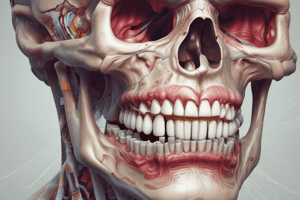Podcast
Questions and Answers
What is the average size of the apical foramen in maxillary teeth?
What is the average size of the apical foramen in maxillary teeth?
- 0.2 mm
- 0.3 mm
- 0.4 mm (correct)
- 0.5 mm
Where are accessory root canals numerous in the radicular pulp?
Where are accessory root canals numerous in the radicular pulp?
- Near the pulp chamber
- Coronal third of the root
- Middle third of the root
- Apical third of the root (correct)
In which zone of the pulp does dentin formation occur?
In which zone of the pulp does dentin formation occur?
- Radicular pulp zone
- Central zone (pulp core)
- Peripheral zone (odontogenic zone) (correct)
- Coronal pulp zone
What is the mechanism of the formation of accessory root canals due to early degeneration of the epithelial root sheath of Hertwig?
What is the mechanism of the formation of accessory root canals due to early degeneration of the epithelial root sheath of Hertwig?
What connects the pulp organs with the periapical tissue?
What connects the pulp organs with the periapical tissue?
During which phase of active eruption does the actual axial (vertical) movement of the tooth from its developmental position to its functional position in the occlusal plane inside the oral cavity occur?
During which phase of active eruption does the actual axial (vertical) movement of the tooth from its developmental position to its functional position in the occlusal plane inside the oral cavity occur?
Which type of tooth eruption involves the apical recession of gingival tissue exposing more tooth structure into the oral cavity?
Which type of tooth eruption involves the apical recession of gingival tissue exposing more tooth structure into the oral cavity?
In which phase of tooth development do deciduous and permanent teeth germs found within the jaw bones before they begin to erupt?
In which phase of tooth development do deciduous and permanent teeth germs found within the jaw bones before they begin to erupt?
What is the pattern of pre-eruptive movements for permanent teeth during the Pre-eruptive phase?
What is the pattern of pre-eruptive movements for permanent teeth during the Pre-eruptive phase?
What type of eruption does not involve tooth movement but occurs due to the apical recession of gingival tissue exposing more tooth structure into the oral cavity?
What type of eruption does not involve tooth movement but occurs due to the apical recession of gingival tissue exposing more tooth structure into the oral cavity?
What are the two major properties that distinguish dentin?
What are the two major properties that distinguish dentin?
What covers dentin in the crown and in the root?
What covers dentin in the crown and in the root?
Where are the odontoblasts aligned on the dentin surface?
Where are the odontoblasts aligned on the dentin surface?
What is the unit structure of dentin that houses odontoblastic processes?
What is the unit structure of dentin that houses odontoblastic processes?
What is the color of dentin and how does it change with age?
What is the color of dentin and how does it change with age?
Flashcards
Apical foramen size (maxillary teeth)
Apical foramen size (maxillary teeth)
Approximately 0.4 mm.
Accessory root canal location
Accessory root canal location
The apical third of the root.
Pulp zone with dentin formation
Pulp zone with dentin formation
The peripheral zone (odontogenic zone).
Accessory root canal formation mechanism
Accessory root canal formation mechanism
Signup and view all the flashcards
Pulp organ connection
Pulp organ connection
Signup and view all the flashcards
Tooth's axial movement phase
Tooth's axial movement phase
Signup and view all the flashcards
Gingival recession tooth eruption type
Gingival recession tooth eruption type
Signup and view all the flashcards
Tooth development phase
Tooth development phase
Signup and view all the flashcards
Pre-eruptive movement (permanent teeth)
Pre-eruptive movement (permanent teeth)
Signup and view all the flashcards
Eruption via tissue recession
Eruption via tissue recession
Signup and view all the flashcards
Dentin's major properties
Dentin's major properties
Signup and view all the flashcards
Dentin covering
Dentin covering
Signup and view all the flashcards
Odontoblast alignment location
Odontoblast alignment location
Signup and view all the flashcards
Dentin's unit structure
Dentin's unit structure
Signup and view all the flashcards
Dentin color
Dentin color
Signup and view all the flashcards
Study Notes
Pulp and Dentin
- The average size of the apical foramen in maxillary teeth is not specified.
- Accessory root canals are numerous in the radicular pulp.
- Dentin formation occurs in the zone of the pulp.
Tooth Development and Eruption
- During the active eruption phase, the actual axial (vertical) movement of the tooth from its developmental position to its functional position in the occlusal plane inside the oral cavity occurs.
- In the pre-eruptive phase, deciduous and permanent teeth germs are found within the jaw bones before they begin to erupt.
- The pattern of pre-eruptive movements for permanent teeth involves eruption pathway formation and tooth movement in a curved direction.
Eruption Types
- Passive eruption involves the apical recession of gingival tissue exposing more tooth structure into the oral cavity, without actual tooth movement.
- Active eruption involves actual tooth movement from its developmental position to its functional position in the occlusal plane.
Dentin Properties and Structure
- Dentin has two major properties: hardness and transparency.
- Dentin is covered with enamel in the crown and with cementum in the root.
- Odontoblasts are aligned perpendicularly on the dentin surface.
- The unit structure of dentin that houses odontoblastic processes is the dentinal tubule.
- Dentin is initially yellowish in color, which darkens with age.
Studying That Suits You
Use AI to generate personalized quizzes and flashcards to suit your learning preferences.




